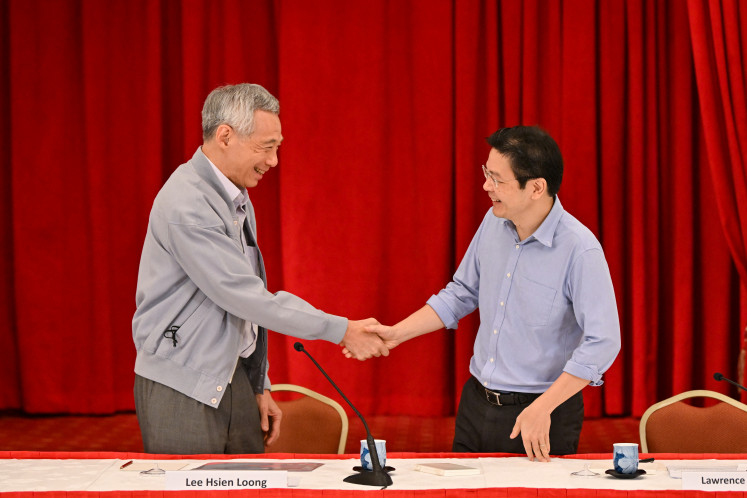Indonesia wants cut in rubber output, exports
After coming to an agreement with fellow top rubber producers Thailand and Malaysia to further cut exports by the end of this year, Indonesia will also attempt to persuade the two countries to reduce their production in order to stabilize rubber prices, which have been on a downward trend for years
Change Size

A
fter coming to an agreement with fellow top rubber producers Thailand and Malaysia to further cut exports by the end of this year, Indonesia will also attempt to persuade the two countries to reduce their production in order to stabilize rubber prices, which have been on a downward trend for years.
Coordinating Economic Minister Darmin Nasution said in Jakarta on Thursday that besides dealing with Thailand and Malaysia, Indonesia would also approach emerging rubber producer Vietnam to make the same approach in order to prop up prices.
“The key is we need to talk with Vietnam, Thailand and Malaysia to discuss the possibility of reducing our rubber production together, Darmin said. “We need to convince them so that we can jointly replant the rubber trees.”
He said Indonesia would use the opportunity provided by low rubber prices to rejuvenate old rubber plantations in order to help reduce the market glut. Darmin said that Indonesia also wanted other producers to carry out a similar rejuvenation programs so that it would make a significant impact on reducing oversupply in the world market.
“Rejuvenation would be the right move because the trees have become too old,” he said. Some of the country’s rubber trees are more than a century old.
Grouped in the International Tripartite Rubber Council (ITRC), Indonesia, Thailand and Malaysia signed an agreement in February to cut exports by 615,000 tons in the six months until Aug. 31. As a strategic partner, Vietnam also agreed to cut its exports by 85,000 tons. In total, the cuts in exports amount to 700,000 tons.
The move was expected to lead to a recovery in rubber prices, which have plunged 70 percent over the past five years. As Vietnam failed to meet its commitment, the three ITRC members, which supply 67 percent of the world’s rubber, have agreed to take over Vietnam’s export quota and will implement the export restrictions until the end of this year.
“I guess it’s still a good thing for us as rubber prices have slightly recovered. Since we implemented the restriction policy, the price has increased to US$1.50 per kilogram and settled down to $1.30 per kilogram recently, up from $1 per kilogram earlier this year,” Indonesian Rubber Producers Association (Gapkindo) chairman Moenardji Soedargo said.
Furthermore, Moenardji said that ITRC should persuade more rubber producer countries, such as Cambodia and Myanmar, to join the council so that they could together stabilize global rubber prices by showing the “spirit of ASEAN”.
Gapkindo estimates with the export cut deal Indonesia’s total exports would decline this year to 2.45 million tons from 2.6 million tons last year. Meanwhile, the country’s rubber production is also expected to fall to 2.95 million tons from 3.15 million tons last year because of the La Niña weather phenomenon that has been predicted for the second half of this year.
Moenardji expected the government to start promoting the rubber processing industry so that production would be more diversified and some of the rubber could be used for road construction. He estimated that Indonesia’s infrastructure development can absorb about 100,000 tons of domestic rubber annually.
Separately, Darmin also said that rubber could be used as a material to build roads, port dock fenders, or even railroads.
“Indeed, rubber asphalt is 20 percent more expensive than the usual one, but the durability of the roads will increase by 50 percent by using it,” he said.
Previously in February, the government said it would closely monitor and make sure 30 priority infrastructure projects across the country would finish within the next four years to help boost economic growth.
According to a blueprint from the Committee for the Acceleration of Priority Infrastructure Delivery (KPPIP), the priority projects will be constructed in the 2015 to 2019 period with a total investment of
Rp 819.41 trillion ($61.8 billion). (vps)
--------------
To receive comprehensive and earlier access to The Jakarta Post print edition, please subscribe to our epaper through iOS' iTunes, Android's Google Play, Blackberry World or Microsoft's Windows Store. Subscription includes free daily editions of The Nation, The Star Malaysia, the Philippine Daily Inquirer and Asia News.
For print subscription, please contact our call center at (+6221) 5360014 or subscription@thejakartapost.com









